2013 Cadillac ATS: First Drive

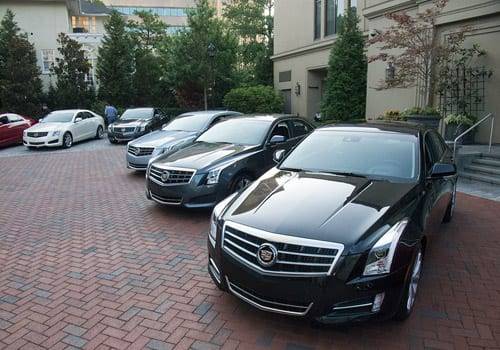
Taking on the leader in any sport, market or prison yard is ballsy and — for those who aspire to greatness — an excellent strategy. Talking trash, on the other hand, might be a pointless and foolhardy one. Cadillac has done both of these things with its new 2013 ATS compact sedan by throwing down the gauntlet against the BMW 3 Series in its Super Bowl commercial this year.
Wasn’t the underachieving CTS sedan supposed to compete in this space? Well, it was always larger, and in preparation for the ATS, which starts at $33,990 (including an $895 destination charge), Cadillac has discontinued the base CTS sedan, which for 2012 was priced at $36,810. For 2013 the CTS sedan line starts with the Luxury trim, priced at $39,990. We reported the ATS’ pricing earlier.
To use the BMW 3 Series for comparison, there’s now a 328i and a 335i, both of which have turbocharged four-cylinder and six-cylinder engines. Cadillac introduces the ATS 2.0L Turbo and ATS 3.6L, named for their turbocharged 2.0-liter four-cylinder and normally aspirated 3.6-liter V-6 engines, respectively. The ATS also has a base engine, a normally aspirated 2.5-liter four-cylinder.
All engines mate to a six-speed automatic transmission, but only the 2.0L offers a manual as a “delete option” that knocks $1,180 off the price. All-wheel drive is optional on the 2.0L and 3.6L. The 2.5L is rear-wheel drive only. In addition to the base ATS, the car comes in Luxury, Performance and Premium trim levels, or “collections,” as Cadillac calls them. I drove almost every combination.

Drivetrains
Endowed with 202 horsepower and 191 pounds-feet of torque, the 2.5L accelerates from zero to 60 mph in roughly 7.5 seconds. It’s a decent clip, but it feels poky sometimes because the car’s suspension can harness much more. The 3 Series no longer includes an engine this modestly powered.
The ATS 2.0L makes 272 hp and 260 pounds-feet of torque, and it feels similar to BMW’s turbo four: plenty of low-rev torque and quick sprints. When equipped with rear-wheel drive, the 2.0L hits 60 mph in 5.7 seconds with the automatic and 5.8 seconds with the manual, according to Cadillac.
The 3.6L’s V-6 generates 321 hp but only 275 pounds-feet of torque, so it didn’t feel much quicker than the 2.0L in normal driving. The 2.0L’s turbo engine hits its torque peak around 1,700 rpm and stays there through 5,500 rpm, while the 3.6L’s V-6 peaks closer to 5,000 rpm — in a car with a 7,200-rpm redline. Only when it was truly wound out did the V-6 earn its keep. Cadillac estimates its zero-to-60 time at 5.4 seconds.
If the acceleration estimates are correct, the ATS’ more powerful variants essentially match the 328i and 335i sedans, even though the ATS has horsepower and weight advantages over comparable automatic BMWs: The 2.0L has 32 more hp and is 88 pounds lighter than the 328i, and the 3.6L has 21 more hp and is 133 pounds lighter than the 335i. However, the 3 Series’ eight-speed transmission is an advantage in its own right.
As of this writing, only the base ATS 2.5L has EPA-certified mileage ratings: 22/33 mpg city/highway. Cadillac estimates 22/32 mpg for the 2.0L and 19/28 mpg for the 3.6L. BMW’s EPA-certified ratings are 23/33 mpg for both the 328i and the 335i. (All mileage specs cited are for automatic, rear-drive versions.) Another advantage for Cadillac is that the 2.5L and 3.6L use regular gas. The 2.0L prefers premium for full output but can also run on regular, Cadillac says.
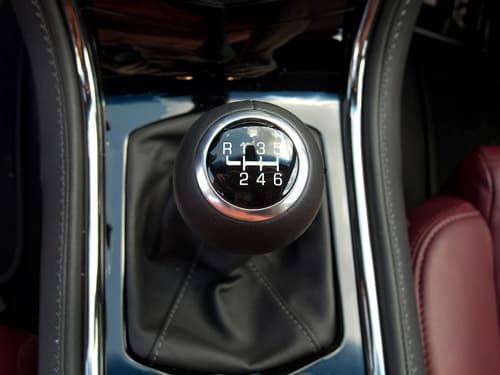
The ATS’ standard transmission is a no-nonsense unit with automatic Touring, Sport and Snow modes. You can shift manually by moving the gloriously conventional gear selector to the left and then pushing it forward and back. (Magnesium steering-wheel shift paddles come only on the Performance and Premium trim levels.) The transmission is more responsive than the CTS’ automatic, which I’ve criticized for excessive lag. It upshifts smoothly and doesn’t dally when you call for passing power.
Although I love manual transmissions, I’m lukewarm on the execution with the 2.0L. When you hit the clutch and let off the gas to upshift, the engine speed drops so lazily that it’s not rev-matched enough when you let the clutch back out. The transmission bucks back as a result in the lower gears. I also found it too easy to catch the Reverse gate, which is to the left, when going for 1st or 2nd gear. You can rev-match better on the downshift because the accelerator doesn’t exhibit too much lag, especially when Sport mode is engaged, as it makes the throttle more sensitive.
The ATS does a pretty good job of damping out engine sounds — always a concern with the capable but raucous Ecotec engine family. BMW’s turbo four sounds faintly diesel at idle but improves with speed. Of the three ATS engines I drove, the sound of the 3.6 stood out to me — not in a positive way. I quickly tired of the engine’s droning sound when cruising on the highway. Otherwise, the ATS’ cabin is admirably quiet, with the main source of noise being the tires, plus the occasional wisp of wind noise.
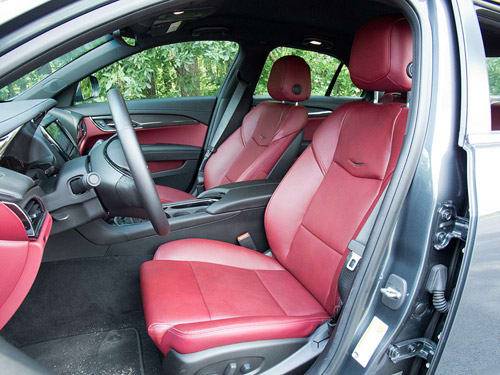
Ride Quality
The ATS’ ride quality is confident and comfortable. A difference of 1 inch in wheel diameter isn’t always noticeable, but I found the 2.5L with its 17-inch wheels to ride a little softer than the other versions I drove, which had 18-inch wheels. The difference was felt mainly over rippled surfaces and tar patches.
All engines and trims come with the same suspension except for the Premium trim level with rear-wheel drive, which includes Magnetic Ride Control, or MRC. This adaptive suspension automatically adjusts shock-absorber firmness on the fly to match road conditions. It teams with upgraded Brembo brakes and Bridgestone Potenza summer performance tires.
It seems unwise that all-season tires aren’t offered with MRC. At minimum, all-season tires should be a no-cost option. Perhaps the thinking is that anyone who’s concerned about wintry conditions would buy the all-wheel drive, which rules out both MRC and summer tires. But that raises a question: Why should MRC be denied to anyone who wants all-wheel drive or all-season tires? Cadillac needs a solution here.
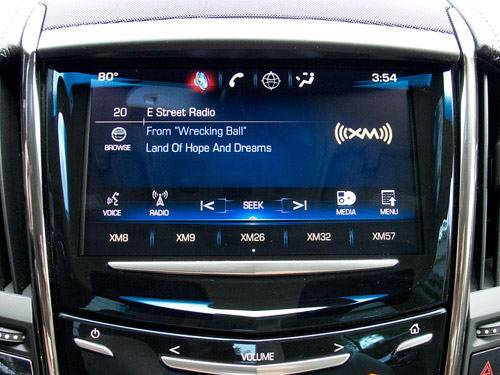
Handling
The ATS’ handling is the car’s claim to potential fame. Several Cadillac models have been introduced since the 2003 CTS sedan set the company’s new tone for world-class athleticism, yet none has come close — until now. With its balanced weight distribution, light weight (hardly a GM strong suit) and meticulously tuned suspension, the car has great reflexes both on the road and on the track.
I took a few blistering laps in a 2.0L manual and a 3.6L automatic at Atlanta Motorsports Park, the latest entry in our country’s growing members-only racetrack phenomenon. The Bridgestone summer tires were fantastic and very well-matched to the cars, both of which had the MRC suspension.
Robbing the ATS 2.0L Turbo of its composure was like trying to get a reaction out of a Buckingham Palace guard. I kept adding more and more speed through the hairpins, trying to unsettle it, with limited success. Only with the added power of the V-6 was I able to induce some under- and oversteer. Were it not for the electronic stability system’s Competition mode — a provision only of the MRC suspension that allows more sliding — the dynamics would have been so good as to be boring.
The V-6 immediately felt more nose heavy to me than the four-cylinder cars. Cadillac says it shifts the weight distribution forward to 51.5/48.5 percent front/rear versus 50.1/49.9 with the 2.0L manual. That might not seem like much, but it was my first impression both on the track and on the road.
The electric power steering is precise and well-tuned — not the best feedback I’ve experienced, but certainly not the worst. The brakes were similar — not the best feedback and pedal feel, but fine controllability, very linear on application and decent on release, both with the standard and Brembo brakes.

Exterior
The ATS looks good on the road. You never can tell for sure at an auto show, where I thought the headlights were too slit-like, and I wasn’t sure about the hump in the trunk lid, accented as it is by the combination spoiler/brake light. I’m still not sure about the latter, but it’s not bad with certain exterior colors. If anything, Cadillac could have taken the design further; it looks conservative compared with the CTS’ giant grille and flared fenders.
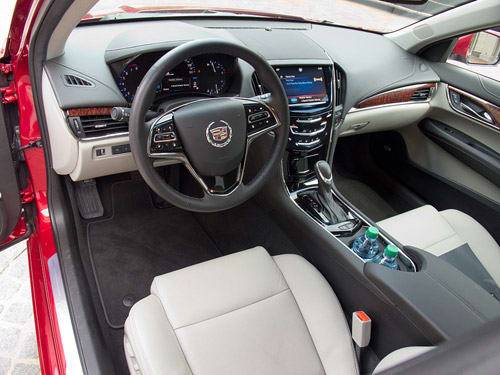
For Better and Worse
Without a doubt, the ATS feels a lot like the recently redesigned 3 Series sedan, with comparable attributes inside as well. The backseat has almost a half-inch more legroom than the 3 Series, but it’s snug, and my legs were raised more than I would like. Mostly I noticed the 1.7 inches less headroom, which made it just workable for me at 6 feet tall. The long front-seat travel, however, provided legroom for people taller than me.
The cabin is well-appointed, with high-quality materials like aluminum, wood and carbon fiber. The optional Cadillac User Experience system with its advanced touch-screen is sure to appeal to people wary of multifunction controller knobs, but I don’t think history will be kind to the touch-sensitive “capacitive” non-buttons the industry is adopting. I know I won’t be.
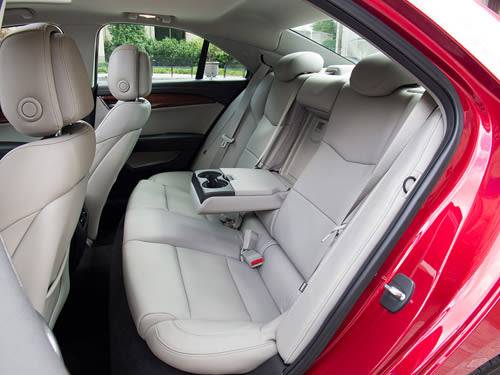
Overall, Cadillac seems to have done a good job squaring up against BMW, for better and for worse. For example, you can get an advanced head-up display … and you can also pay extra for items like leather upholstery and a folding backseat. That’s definitely meeting the competition on its own turf.
BMW’s compact-luxury king has been “gone after,” “gunned for” and “taken on” more than any model in the market, and still his highness remains on the throne, his anteroom littered with bones. We’ll need more time with the ATS to know whether it’s merely a pretender to the throne. So far it looks as close as any challenger to date.
Related
Research Luxury Cars
2012 BMW 3 Series Review
More Cadillac News

Former Executive Editor Joe Wiesenfelder, a Cars.com launch veteran, led the car evaluation effort. He owns a 1984 Mercedes 300D and a 2002 Mazda Miata SE.
Featured stories




